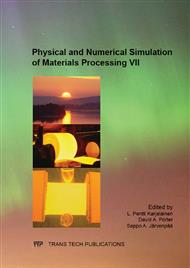p.578
p.584
p.590
p.596
p.602
p.607
p.612
p.621
p.627
Effect of Sn Content on the Microstructure, Mechanical and Electrical Properties of Ti2AlC/Cu Joints Brazed with Cu-Sn-Ti Filler Alloy
Abstract:
In the present study, Cu-Sn-Ti filler alloy with different content of Sn was used to join Ti2AlC ceramic and copper at 950 °C for 10 minutes. Effect of Sn content on the microstructure, mechanical property and electrical conductivity of the joints were investigated.The results indicate that the joint was comprised of five parts: copper substrate/ diffusion area in the copper substrate (Cu [Al, S solid solutions)/ brazing layer (Cu [Al, S+CuSn3Ti5)/ interaction area in the Ti2AlC substrate (Ti2AlC+ Cu [A+AlCu2Ti+TiC)/ Ti2AlC ceramic substrate.With the content of Sn element in the joint increasing, the filler alloy performed lower melting point and better fluidity during brazing. Thus partial filler alloy flowed out of the brazing seam, leading to the reduction of CuSn3Ti5 phases. Simultaneously, more Ti and Al diffused toward the Cu substrate, where a line of AlCu2Ti phases was formed. The maximum shear strength 158.5 MPa was obtained by using Cu80Sn10Ti10 (at.%) filler alloy, at which the joint strength was 71% of that of the Ti2AlC ceramic. The joint strength was deteriorated while the higher content of Sn was incorporated (>10 at.%), which was caused by the weak interfacial bonding between the substrates and the brazing layer. Besides, the electrical conductivity was decreased from 5.65×106 s/m to 4.99×106 s/m with increasing Sn content in the filler alloy.
Info:
Periodical:
Pages:
602-606
Citation:
Online since:
July 2013
Authors:
Price:
Сopyright:
© 2013 Trans Tech Publications Ltd. All Rights Reserved
Share:
Citation:


